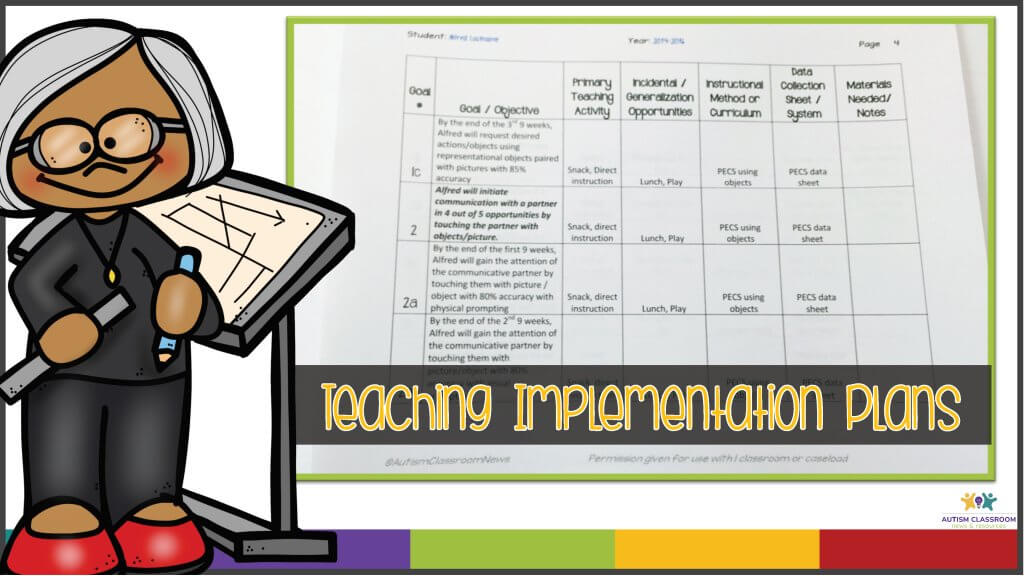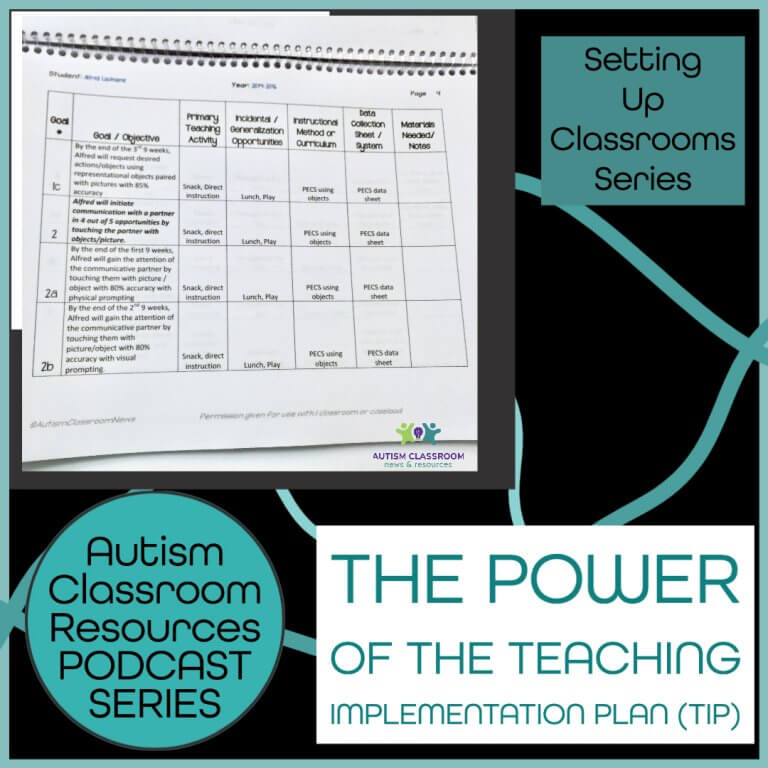I developed the Teaching Implementation Plan (TIP), which I’ve sometimes named the Teaching Plan or the Teaching Intervention Plan, when doing regular child study meetings with staff in a program I was running. The staff I was meeting with were struggling with being able to talk about how they were teaching the students’ goals. They were newer teachers with limited experience. They were great with the students. But no one had taught them how to talk about what they did or how to plan it out was. So I needed a tool to help them plan and organize what they were teaching and how they were teaching it.
What Can the TIP Do For You?
- Imagine knowing, as you start the classroom setup process, what every student’s needs are and how you plan to implement them in the classroom and/or at home.
- What if you had a document you could hand to paraprofessionals that would not only make sure they know the IEP goals, but that they would know where and how to teach them and take data?
- And what if you had a document that helped you plan out distance learning as well as classroom learning and communicate it to the family?
Well the Teaching Implementation Plan can help you with all of those and help get your classroom foundation off to a strong and solid start.
What is the Teaching Implementation Plan?
I’ve often described the TIP as what every experienced teacher had in their head put on paper. It is essentially a plan for how you plan to implement the IEP. You can use it to include curriculum items too, but I usually focus on just the IEPs.
In a nutshell, the TIP outlines where and when the skill needs to be taught, how it’s going to be taught, and how you are going to track the data. It’s kind of like an intervention plan for a student that is used to drive classroom development. Yell and Bateman (2020) described the IEP as the blueprint to FAPE. I like to think of the TIP as the shop drawings that are used to implement it.
Why Start Classroom Setup with the TIP?
The primary reason for starting classroom setup with the Teaching Implementation Plan is precisely because it is a plan. Special education classrooms won’t look the same from year to year. Because we design the classroom around the needs of the students. This is true whether you are designing a resource room, a self-contained room, or really a general education room. It’s just much more evident in the special education settings because the needs of our students are so diverse.
Know Your Students
In order to really design a classroom that will meet the needs of your students, you have to know the needs of your students. And the IEP is the document that will lead us to that, followed by our curricula. Once I have the TIP completed, I really know the needs of the student. I’ve planned out what types of activities are needed for the student to learn his IEP goals. Plus, I’ve thought about how I’m going to teach the skill. And I know what type of data I need.
Each Class is Different
Those are all critical elements in the classroom design process. Sometimes we might have a classroom of students who all need group activities to work on learning effectively in group settings. Maybe typically your classroom has students who go in and out frequently to general education classroom. But, this year most of your students really need significant explicit instruction on basic skills in small groups of 1 or 2. Those 3 classrooms are going to look very different from schedule, to physical layout to staffing. The TIP can help you learn who your students are, what their needs are, and how to program for them.
[socialpug_tweet tweet=”The Teaching Implementation Plan can help you learn who your students are, what their needs are, and how to program for them. #specialeducation #classroomdesign #tipforclassrooms” display_tweet=”The Teaching Implementation Plan can help you learn who your students are, what their needs are, and how to program for them.” style=”2″]
How Can the TIP Help in Fall 2020?
Ah, that’s a great question. We are designing classrooms this fall in the world of uncertainty. Are we going to be in the physical classroom at all? Will we be online all year? Part of the year? What about blended learning?
And I suspect that it’s going to be different for each one of you. And it may not be the same throughout the year. Given all of that uncertainty, planning is going to be that much more important.
You may say, “Planning? How can I plan when I don’t know the plan?” If you develop the TIP from the students’ IEP, you will be able to plan out what can be taught at home and how. It will give you the opportunity to think through what supports families may need this year. And it will help to assure that whether you are providing in-class learning, blended learning or distance learning, that you have planned for each element of the IEP in those settings.
Elements of the Teaching Implementation Plan
- Goals and Objectives from the IEP. These need to be well defined and clear.
- Primary Activity. That’s the type of activity, or the activity on your schedule, that provides the most opportunities for the student to practice their skills. Let’s face it, most of our students are not one-trial learners. They need repetition. The primary teaching activity is where we get those opportunities and also where we are planning to take data.
- Incidental / Generalization Activities: Next, think about how the student will generalize his or her learning from your primary activity. What are other activities that he can use the skill during the day? These are the activities that
- Instruction Method: This is HOW you are going to teach the skill. What strategy or curriculum will you use?
- Data Collection: This is what type of data, how often and what tool you will use to take the data. This is affected by mastery criteria in the IEP as well as staff availability and classroom concerns.
- Materials and/or Notes: This is just a column I use to write in what materials I need to make or get, things I need to remember. It’s also a good place to write in parent supports if you are distance learning.
All of these things may change some as you move through the classroom design process. As you look at your schedule, you may need to adjust primary activities to match. Or you may find that the data collection strategy won’t work well at that time with the staffing you have. So this whole designing classroom process is definitely an integrated process.
6 Ways the TIP Can Help You
The Teaching Implementation Plan is an Overview of the IEP
As an overview of the IEP this is one of the biggest advantages for me of the TIP. When I get all the TIPs done for a classroom, I know all the needs of the students in the class. And I have an idea of what types of strategies and activities they need to learn their goals. That way, while the classroom might change over time once the students start the year, but I start the year with a plan for each student.
The TIP Helps Think Through Instruction
It’s becoming increasingly important, and especially with distance learning, that educators be able to both implement and talk about their teaching strategies. The Teaching Implementation Plan helps teachers think through how they are going to teach the student. Are you going to use discrete trials? Or PECS? Or maybe you are using the Unique Learning System lessons or another curriculum that has the teaching steps built in. Our instruction for students in special education needs to be explicit. The TIP helps you plan out what that looks like.
TIP Assures Data Collection for Each IEP Goal/Objective
I find this is one of the things most people like about the TIP. Once you have completed a TIP for each student, you know what data sheets to pull and how you are going to integrate data collection into your schedule. It also makes sure that every goal and/or objective is accounted for in data collection.
Assists with Communication with Staff
I noted earlier that the TIP is the outline for the classroom that experienced teachers probably have in their head. But there is great value in putting that knowledge and that planning on paper. The primary advantage is that you can communicate with staff. There are tons of reasons why I like the TIP for communicating with the staff. However, the most significant reason is that staff doesn’t know what skills you are planning to teach embedded into classroom activities unless you inform them.
It may seem to be a natural strategy for you to embed requesting materials into an activity because you want the student to learn to make requests. But that doesn’t mean that other staff in the classroom know that is what you are trying to teach. So they just give the student all the materials he needs. The TIP communicates to them what you are focused on. It also helps them review the IEP in the way it’s going to be implemented, rather than just a legal document list of goals.
Communication with Families
I think this reason is going to be a hugely important reason for the Teaching Implementation Plan in Fall 2020. If you are doing distance or blended learning, you are going to need to think about what skills the student is going to learn and how he is going to learn it outside the classroom. If it’s blended, what skills are you going to teach at school? And how are they going to be generalized or taught at home? It also helps families to see how the IEP is going to be implemented in your classroom. And therefore it helps to build trust. I think going forward in this fall, that might be the biggest reason to use the TIP.
Builds the Schedule Around the Students
Finally, back to the primary purpose of this podcast series, how does the TIP help design the classroom? Well once I have the TIP done for each student, I know what activities need to go on my schedule. And I have an idea of how much time will be needed with different activities. It assures that the schedule I develop will meet the unique needs of the students in the classroom this year.
So that will bring us to our next step in the series: developing the classroom schedule. I’ll be back next week with tips on how to develop a classroom schedule that works for all the students. And I will share how I build a classroom schedule the embeds instruction into the activities of the day.
In the meantime, if you are looking for more resources on how to create TIPs for your students and develop your schedule, check out the Teaching Plan and Scheduling Toolkit here.







